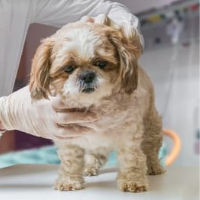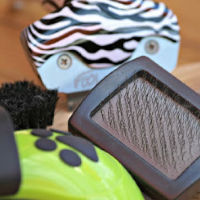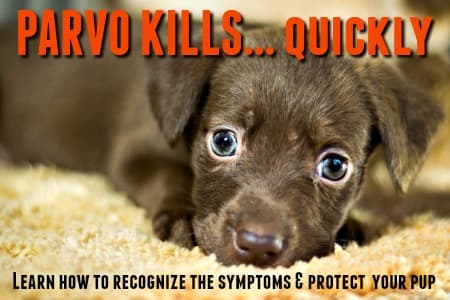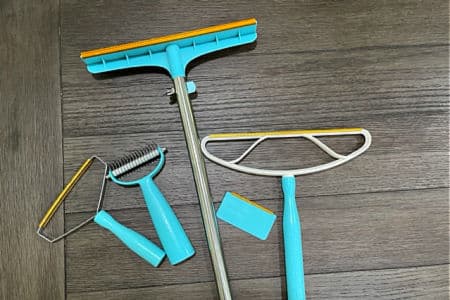FYI: If you buy something through a link on this site I may earn a commission - at NO extra cost to you.
All About Puppy Hair Loss
Puppy hair loss can be caused by something as simple as heavy shedding, or by something more serious such as skin problems, parasites and more.
If you're worried about how much (or perhaps how little) hair your puppy has, or notice above-average shedding, bald patches, rashes or irritated skin, then it's important to find out what's causing the problem.. so that you can fix it!
Allergies & Puppy Hair Loss
Allergies are actually more common than most owners realize. Your puppy or dog can develop allergic reactions to an ingredient (or several ingredients) in his food or treats.
Quite often this is to a food that he's been eating and enjoying for some time, but it can also develop after your pup has been given something new or different.
Other common 'triggers' for canine allergy symptoms include fleas and seasonal allergens (such as pollen, weeds, dust etc.)
Some dogs also have 'contact allergies' which means they react to something they come in contact with. This could be a shampoo, topical medication, cleaning product, material or fiber and so on.
Regardless of what causes the allergy, the reaction is usually seen as a skin problem.

Hair loss and/or bald spots are common in dogs with allergies, as are excessive licking or scratching (particularly of the belly, legs, tail or face), red irritated 'hot-spots' or a rash.
You can find out more about recognizing and treating Fido's allergies on my Dog Allergies page.
Shedding or 'Blowing Coat'
Most puppies lose their puppy coat when they're somewhere around 3 - 10 months old, depending on size, breed and coat type.
This sort of puppy hair loss can be more extreme in some breeds than others, Pomeranians are a prime example of this, and may look very 'patchy' for a time.
Adult dogs shed seasonally, usually twice a year at the major change of seasons.
This is often called 'blowing coat' and dog hair loss can be pretty dramatic at this time. Regular brushing and grooming is essential when this happens, to prevent tangles, mats and so on.
A female dog will also shed during her heat cycles, and more heavily after having puppies.
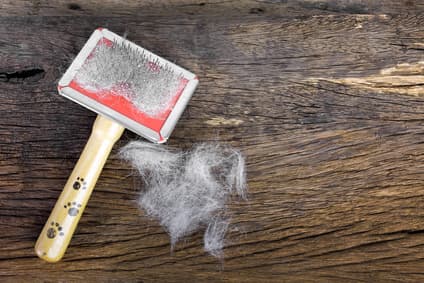
Excessive dog hair loss can also sometimes occur during times of extreme stress such as illness, a reaction to surgery, or other anxiety-inducing circumstances.
Bathing your puppy too often, or with the wrong kind of products, can also cause thinning hair and dry, flaky skin.
There are several natural products and remedies that are gentle and soothing on your pups' skin, check out my Natural Health Products and Natural Remedies pages to see some of the best ones on the market.
Health Issues or Illness
There are quite a few illnesses or health conditions that can cause hair loss in pups and dogs.
Some of them may be congenital, some may be contagious
or a result of parasitic infestation.
Here are a few of the more common medical reasons for a puppy hair loss:
- Cushings' Disease - due to Fido's body producing too much Cortisol. Other symptoms may include recurrent infections, excessive thirst and urination, and weight gain.
- Hypothyroidism - when your puppy or dog's body produces too little thyroglobulin (a hormone). A dog suffering from hypothyroidism may also seem more lethargic than usual, gain weight, be susceptible to infection and have dry, brittle hair as well as patches of hair loss.
- Ringworm - this is actually a fungal infection, rather than a parasitic one. Itching and hair loss, with scaly or crusty areas of skin, are the most common symptoms of Ringworm.
- Yeast Infections - a yeast infection that is a fairly common
cause of puppy hair loss. Moist areas are the most common places for
this infection to show up (such as armpits, behind ears, and in skin
folds).
Dogs with a lot of 'wrinkles' such as English Bulldogs, Shar-Peis etc., are more susceptible to these sorts of infections. In addition to hair loss, greasy skin and a strong odor are tell-tale signs that yeast is the problem. - Mange - this is a parasitic infection, caused by tiny 'mites', and there are two main types.... Sarcoptic mange (also knows as Scabies) and Demodectic mange.
Demodectic mange is more common in young dogs, and puppy hair loss associated with this is usually seen first on the muzzle/face, around the eyes or on the front legs. Mild itchiness can cause Fido to scratch more than usual.
Some breeds such Shar-Peis and Bull Terrier breeds have an increased tendency towards developing demodectic mange, especially if their immune system is stressed.
With Sarcoptic mange a pup or dog will be extremely itchy and uncomfortable, and a dogs' hair loss can be fairly extensive as he may scratch himself very aggressively.
A skin scraping taken by your vet can determine which mite is causing the trouble.
So, the bottom line is, if you're seeing any hair loss in your puppy that seems excessive, or you notice bald spots, bare skin irritation or inflammation, then it's time for a trip to your veterinarian to find out what's going on.
you might also like...
- Home
- Puppy Health Care
- Puppy Hair Loss
FTC Disclosure: Some pages on this site contain affiliate links. I may earn on qualified purchases.
